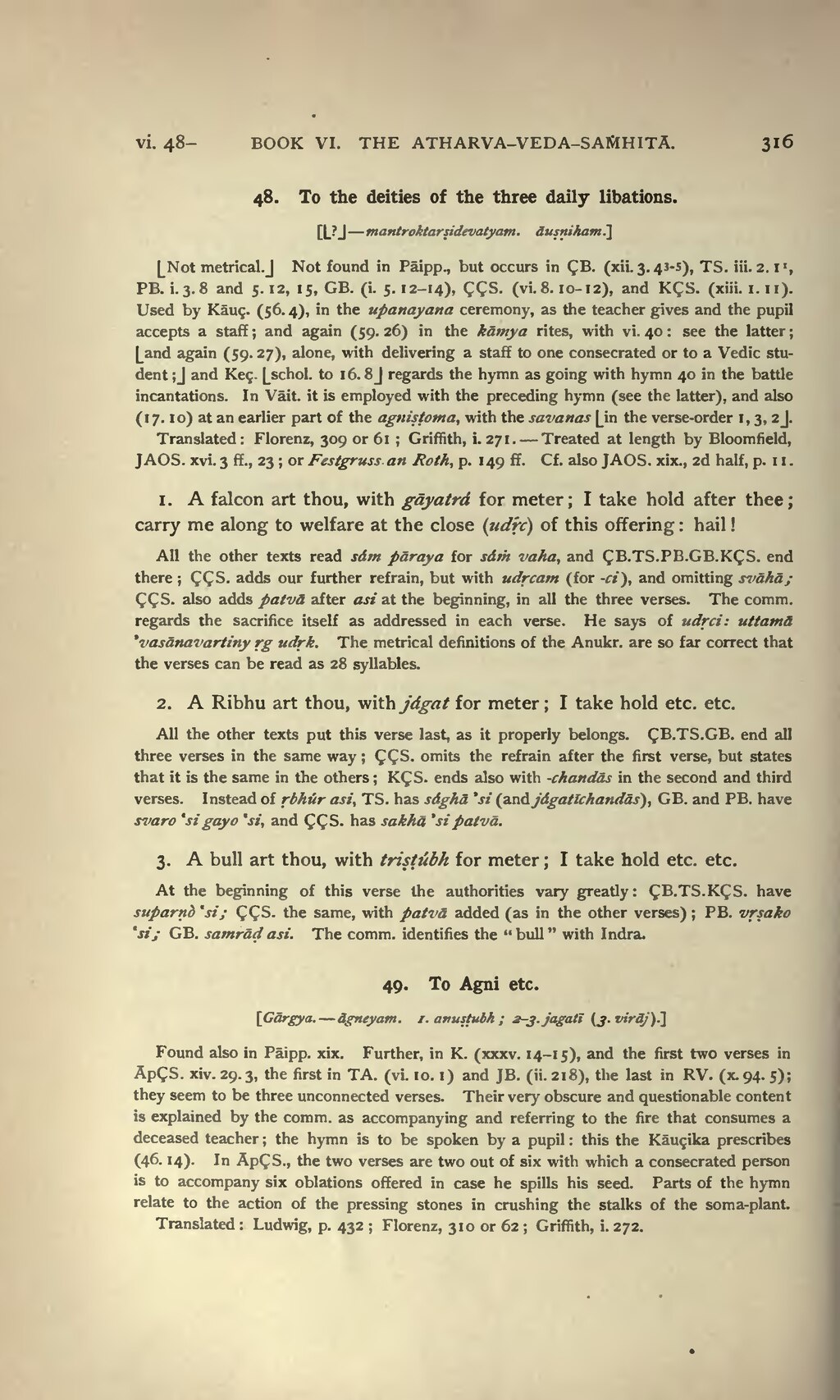48. To the deities of the three daily libations.
[⌊?⌋—mantroktarṣidevatyam. āuṣṇiham.]
⌊Not metrical.⌋ Not found in Pāipp., but occurs in ÇB. (xii. 3. 43-5), TS. iii. 2, 11, PB. i. 3. 8 and 5. 12, 15, GB. (i. 5. 12-14), ÇÇS. (vi. 8. 10-12), and KÇS. (xiii. 1. 11). Used by Kāuç. (56. 4), in the upanayana ceremony, as the teacher gives and the pupil accepts a staff; and again (59. 26) in the kāmya rites, with vi. 40: see the latter; ⌊and again (59. 27), alone, with delivering a staff to one consecrated or to a Vedic student;⌋ and Keç. ⌊schol. to 16. 8⌋ regards the hymn as going with hymn 40 in the battle incantations. In Vāit. it is employed with the preceding hymn (see the latter), and also (17. 10) at an earlier part of the agniṣṭoma, with the savanas ⌊in the verse-order 1, 3, 2⌋.
Translated: Florenz, 309 or 61; Griffith, i. 271.—Treated at length by Bloomfield, JAOS. xvi. 3 ff., 23; or Festgruss an Roth, p. 149 ff. Cf. also JAOS. xix., 2d half, p. 11.
1. A falcon art thou, with gāyatrá for meter; I take hold after thee; carry me along to welfare at the close (udṛ́c) of this offering: hail!
All the other texts read sám pāraya for sáṁ vaha, and ÇB.TS.PB.GB.KÇS. end there; ÇÇS. adds our further refrain, but with udṛcam (for -ci), and omitting svāhā; ÇÇS. also adds patvā after asi at the beginning, in all the three verses. The comm. regards the sacrifice itself as addressed in each verse. He says of udṛci: uttamā ’vasānavartiny ṛg udṛk. The metrical definitions of the Anukr. are so far correct that the verses can be read as 28 syllables.
2. A Ribhu art thou, with jágat for meter; I take hold etc. etc.
All the other texts put this verse last, as it properly belongs. ÇB.TS.GB. end all three verses in the same way; CCS. omits the refrain after the first verse, but states that it is the same in the others; KÇS. ends also with -chandās in the second and third verses. Instead of ṛbhúr asi, TS. has sághā ’si (jágatīchandās), GB. and PB. have svaro ‘si gayo ‘si, and ÇÇS. has sakhā ‘si patvā.
3. A bull art thou, with triṣṭúbh for meter; I take hold etc. etc.
At the beginning of this verse the authorities vary greatly: ÇB.TS.KÇS. have suparṇò ‘si; ÇÇS. the same, with patvā added (as in the other verses); PB. vṛṣako ‘si; GB. samrāḍ asi. The comm. identifies the "bull" with Indra.
49. To Agni etc.
[Gārgya.—āgneyam. 1. anuṣṭubh; 2-3. jagatī (3. virāj).]
Found also in Pāipp. xix. Further, in K. (xxxv. 14-15), and the first two verses in ĀpÇS. xiv. 29. 3, the first in TA. (vi. 10. 1) and JB. (ii. 218), the last in RV. (x. 94. 5); they seem to be three unconnected verses. Their very obscure and questionable content is explained by the comm. as accompanying and referring to the fire that consumes a deceased teacher; the hymn is to be spoken by a pupil: this the Kāuçika prescribes (46. 14). In ĀpÇS., the two verses are two out of six with which a consecrated person is to accompany six oblations offered in case he spills his seed. Parts of the hymn relate to the action of the pressing stones in crushing the stalks of the soma-plant.
Translated: Ludwig, p. 432; Florenz, 310 or 62; Griffith, i. 272.
